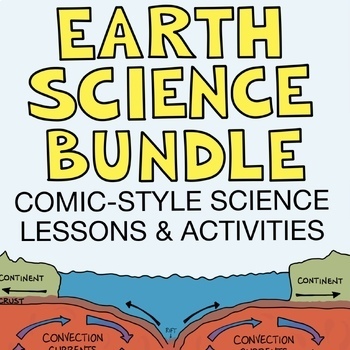Earth Science Curriculum - Extended School Year / Summer School Work Packet
- Zip
- Easel Activity

Products in this Bundle (14)
showing 1-5 of 14 products
Bonus
Description
Revolutionize learning in your summer school curriculum with something they will WANT to read! This unique and impactful Earth Science Bundle is jam-packed with comic-style content, supplementals, and hands-on learning. This bundle will empower even your most reluctant learners to engage in reading and improve their science literacy during the extended school year.
Give your learners a break from screens. Cool School Comics delivers content in comic form, but unlike regular comic books, these comics cover a topic in one compact page making them easy to print and get in the hands of eager readers.
If your students seem bored with the current curriculum it's time to try something new. Take advantage of the graphic novel craze and use comics to teach science!
This bundle includes all of my Earth science comics! I am adding comics all of the time, but so far the bundle includes topics such as:
- Convection Currents
- Erosion
- Fossil Fuels
- Earth's Interior
- The Rock Cycle
- The Water Cycle
- Sudden Earth Changes
- Mass Extinction
- Fossils
- Cold Fronts
- Condensation
- Continental Drift
- Seasons
- Revolution and Rotation
What do you get?
- Comic-Style Content Comics-
- Each topic is covered in a one-page, infographic-style comic.
- These are easy to print and distribute.
- They make great anchor charts!
- Color and black-and-white versions
- Doodle Notes
- Typically at least two different versions of doodle notes- traditional doodle notes and guided notes
- Great for interactive notebooks
- Easy to print and fun to color
- Google Slides
- Many updated products have Google slides and more are being added regularly
- You will receive your own sharable copy of each available animated slideshow
- Use them as you present the content or share them directly with your virtual classroom
- Hands-on Activities
- Activities aligning with the content
- Instructions for the activities are delivered in both a written and visual format
- Always low-prep and wallet-friendly
- Follow-up Questions
- Every activity has an accompanying follow-up worksheet
- Helps students tie the fun back to the content
- Reinforces understanding
- Supplementals
- Many products include a range of additional learning activities
- Diagrams, foldables, mini-research projects, etc
- Great for homework or review
- Projects
- All projects include rubrics (many have differentiated rubrics)
- The "Create Your Own Comic" project is the most common
- Easel Activities
- Accompanying every updated product
- Vintage products in this download will be updated VERY soon
- Rubrics
Grab a FREE Comic While You're Here!
What makes Cool School Comics such an impactful learning tool?
- They are FUN!
- This is the most crucial benefit.
- Students are more willing to participate and more engaged.
- The content STICKS.
- Visual learning is EFFECTIVE.
- About 65% of the population consists of visual learners.
- Visual information is processed faster.
- Students who SEE information are more likely to retain it.
- EASY to implement!
- These lesson plans are complete and ready to go, requiring minimal prep time.
- You only need to make copies, upload supplementals to your virtual classrooms, and set up the hands-on activities.
- Lots of flexibility! You can print these as posters, add them to interactive notebooks, hand them out to students, or share them virtually. There is plenty of room for modifications.
- ACTIVE LEARNING
- Every lesson plan has a low-prep, wallet-friendly, hands-on component.
- Instructions are in a visual format
- Follow-up questions or a lab report are always included
- Comics make content ACCESSIBLE
- Naturally differentiated, comics accommodate a wide range of learning abilities and styles.
- Great for classrooms with a diverse population of learners
- They can simultaneously rope in both your gifted and struggling students (and everyone in between).
- Reluctant readers gravitate toward comics.
- Comics help English Language Learners and SPED students find success.
Be the hip teacher seizing the graphic novels craze. Your students will LOVE it!
*Doodle Notes is a trademarked term used with permission. Please visit www.DoodleNotes.org for more information





